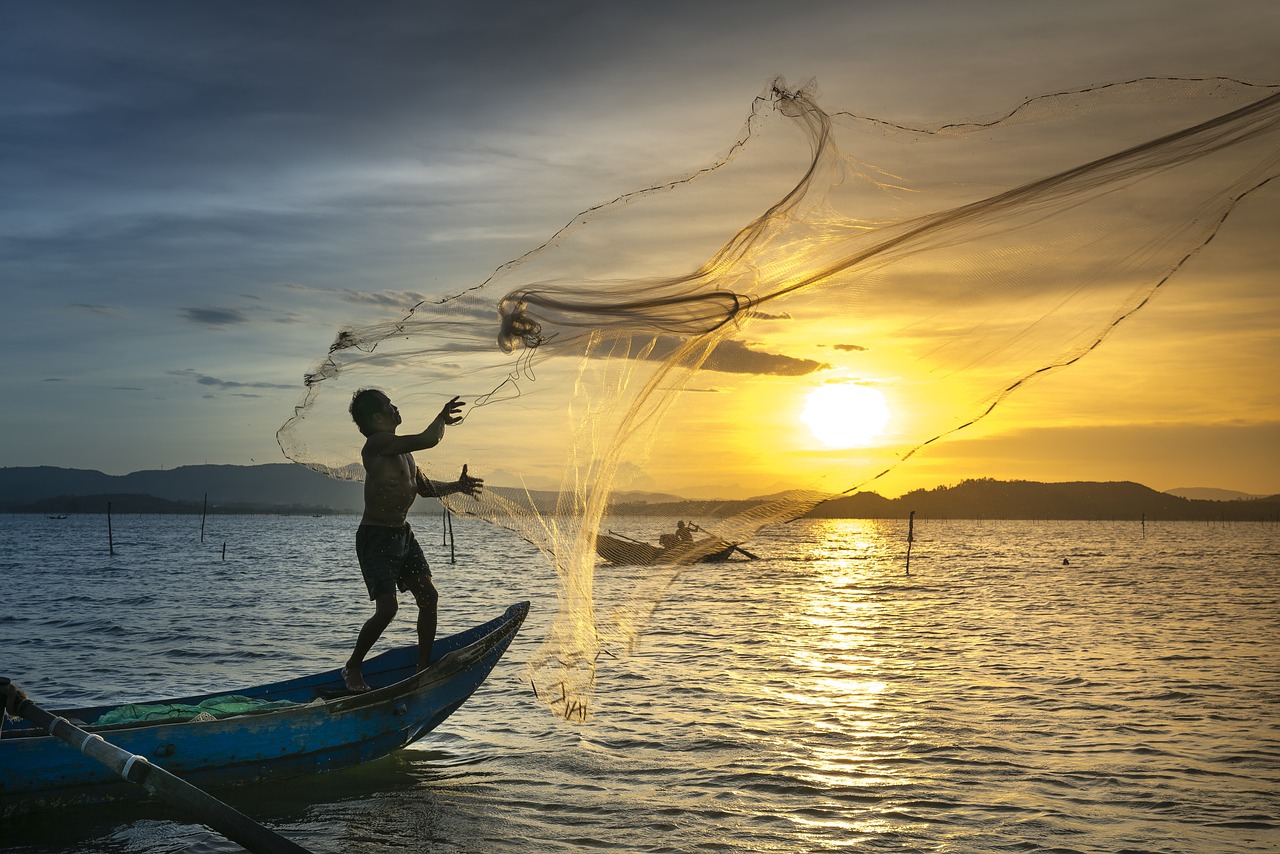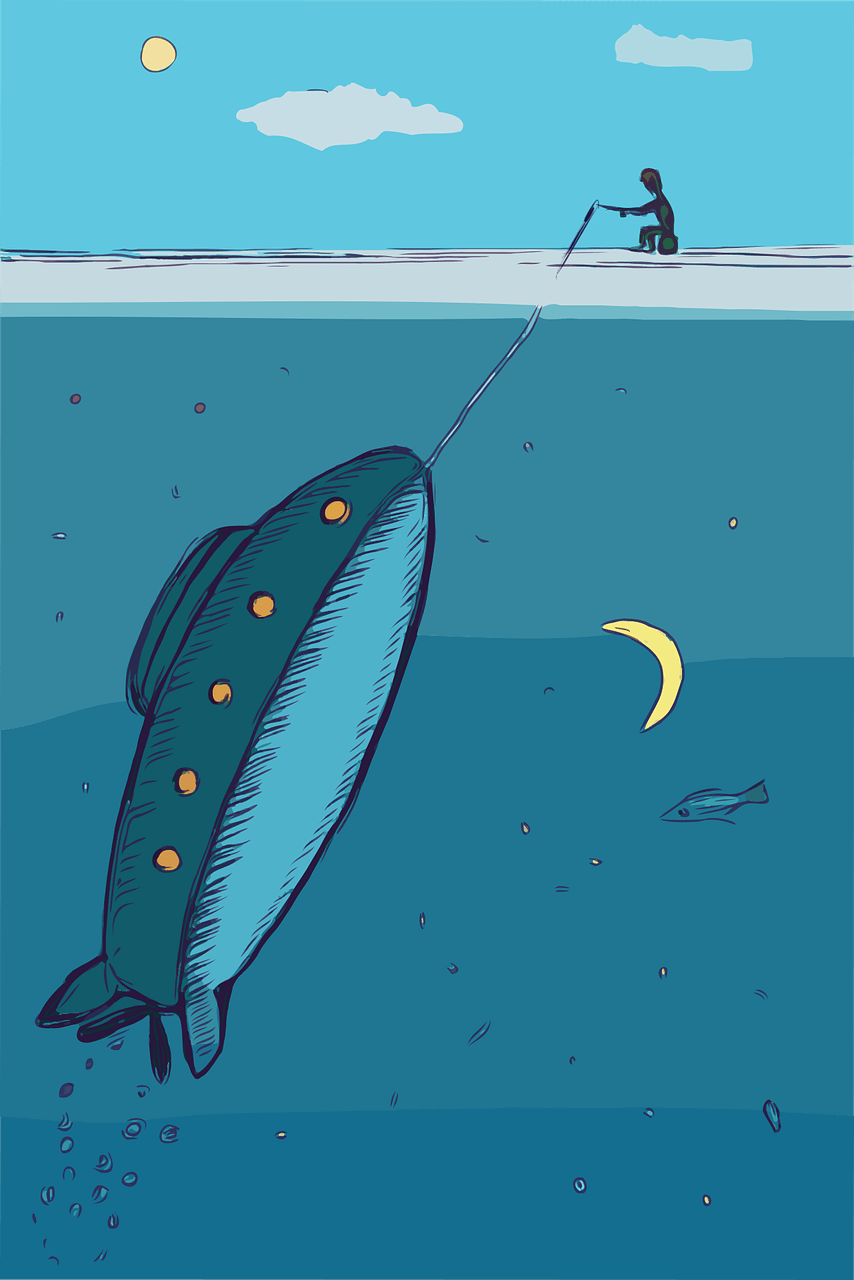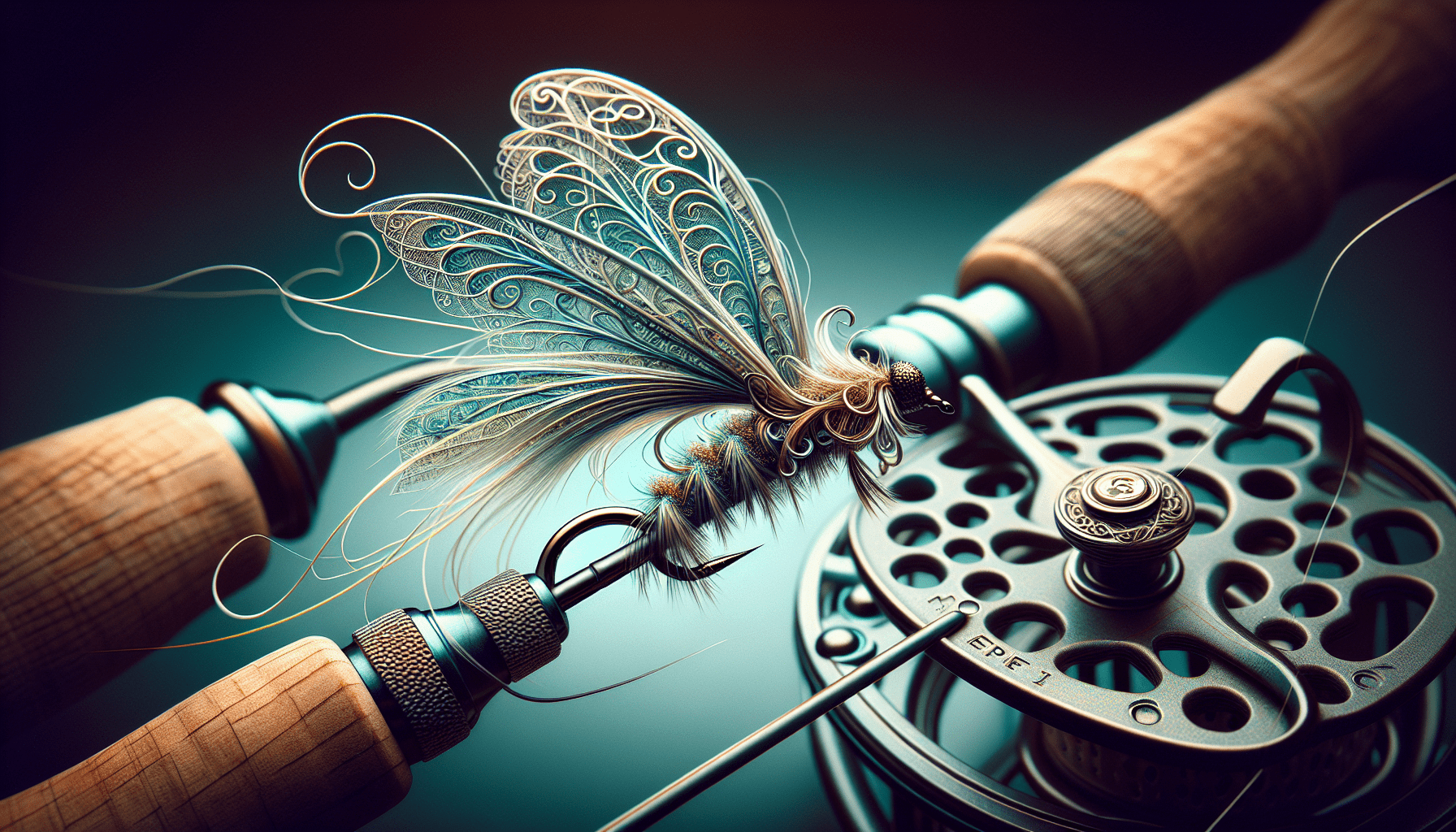Have you ever wanted to learn the art of fly fishing? If so, one of the first things you’ll need to know is how to tie a fly onto a fly rod. Tying a fly is not only essential for fishing success, but it’s also a gratifying skill to master. In this article, we will guide you through the step-by-step process of tying a fly on a fly rod. By the end, you’ll be equipped with the knowledge and confidence to tackle the world of fly fishing with ease. Get ready to take your angling adventure to new heights!

Selecting the Right Fly
Understanding the fish species
When it comes to selecting the right fly, it’s important to have a good understanding of the fish species you’ll be targeting. Different fish have different feeding habits and preferences, so choosing a fly that mimics their natural prey will increase your chances of success. Take the time to research the specific fish species you’ll be fishing for and learn about the insects, baitfish, or other organisms that they commonly feed on.
Choosing the fly pattern
Once you’ve familiarized yourself with the fish species, it’s time to choose the appropriate fly pattern. There are numerous fly patterns available, each designed to imitate a particular insect or baitfish. Consider the size, color, and shape of the natural prey in the area where you’ll be fishing, and try to select a fly pattern that closely matches those characteristics. It’s also helpful to have a variety of fly patterns in your tackle box to adapt to different fishing conditions.
Matching the hatch
Matching the hatch is a crucial aspect of fly fishing. This refers to selecting a fly pattern that closely resembles the insects that the fish are actively feeding on at the time. By observing the insects present on the water’s surface or in the surrounding vegetation, you can determine the most suitable fly to use. Keep an eye out for any emerging insects or any specific patterns of insect activity, as these are prime opportunities to select the right fly and entice the fish to bite.
Considering the water conditions
The water conditions, such as clarity, current speed, and temperature, also play a role in selecting the right fly. In murky or fast-flowing waters, brightly colored flies or streamers that create vibrations and movement may be more effective. On the other hand, in clear and calm waters, imitating delicate and natural-looking insects with more subtle fly patterns might yield better results. Be sure to take into account the prevailing weather conditions and any specific factors that could affect the fish’s behavior.
Gathering the Necessary Materials
Fly rod and reel
To start fly fishing, you’ll need a fly rod and reel. Selecting the appropriate fly rod and reel depends on the fish species you’ll be targeting and the type of water you plan to fish in. Fly rods come in different weights to accommodate various fishing situations, and the reel should be matched to the rod weight. Consider seeking advice from experienced anglers or visiting a reputable fly fishing shop to ensure you choose the right combination.
Fly line
Fly line is a crucial component of fly fishing equipment. It’s essential to select a fly line that matches the weight of your rod and the fishing conditions you’ll be facing. Fly lines are available in different tapers and sinking rates to suit different fishing techniques and water depths. The weight-forward taper is versatile and suitable for most beginners. Again, consulting with knowledgeable professionals will help you make the right choice.
Leader and tippet
Leaders and tippets are used to connect the fly line to the fly. The leader, usually made of monofilament or fluorocarbon, tapers down in diameter from the thicker end that attaches to the fly line to a thinner end where the tippet is attached. The tippet is a smaller diameter section of the leader that connects directly to the fly. The length and strength of the leader and tippet depend on the fishing conditions and the fish species you’re targeting.
Fly tying vise
If you’re interested in tying your own flies, a fly tying vise is an essential tool to have. The vise holds the hook securely while you tie various materials onto it to create the fly pattern. There are different types of vises available, ranging from simple beginner models to more advanced options. Consider your own skill level and budget when selecting a fly tying vise.
Fly tying thread
Fly tying thread is used to secure the materials onto the hook when tying flies. It comes in various sizes and colors, allowing you to match the thread to the fly pattern you’re tying. Choose a thread that is appropriate for the size of the fly and provides enough strength to hold the materials firmly in place.
Fly tying scissors
Fly tying scissors are an essential tool for trimming and shaping the materials used in fly tying. They should be sharp and precise to ensure clean cuts and accurate shaping. Look for scissors specifically designed for fly tying, as they will have the necessary fine points and sharp blades to handle delicate materials.
Hooks
Hooks are the foundation of any fly. They come in different sizes, styles, and strength ratings, so it’s important to choose the right hook for your fly pattern and the fish species you’re targeting. Be sure to have a variety of hook sizes and styles in your tackle box to accommodate different fishing situations.
Feathers, fur, or synthetic materials for fly pattern
The materials used in fly patterns vary depending on the desired imitation. Feathers, fur, and synthetic materials are commonly used to create the body, wings, and other components of a fly. Depending on the fly pattern and the fish species you’re targeting, you may need a variety of materials such as hackle feathers, marabou, deer hair, or synthetic fibers. It’s helpful to have a well-stocked collection of these materials so you can tie different types of flies and experiment with various patterns.
Beads or weight for weighting the fly (optional)
In some cases, adding weight to a fly can be advantageous, especially when fishing in deeper or faster-moving waters. Weighted flies can sink quicker and allow you to reach fish that are holding at different depths. Beads or other weighted materials can be incorporated into the fly pattern to add the necessary weight. However, keep in mind that not all fly patterns require additional weight, and it’s important to consider the fishing conditions and the behavior of the fish before adding weight.
Fly floatant (optional)
Fly floatant is a product designed to help flies stay afloat on the water’s surface. It can be applied to dry flies or other buoyant flies to keep them from sinking and to help mimic insects that float on the water. While not essential, fly floatant can be useful in certain fishing situations, particularly when targeting surface-feeding fish. Apply a small amount of floatant to the fly before casting it onto the water.
Fly fishing knot tools
Having the right tools to tie your fly knots is crucial for a successful fly fishing experience. Knot tools, such as a pair of hemostats or specialized fly tying tools, make it easier to tie the necessary knots securely and efficiently. These tools help ensure that your knots are strong and reliable, minimizing the risk of losing fish due to knot failures.
Setting Up the Fly Rod
Attach the reel to the rod
To set up your fly rod, start by attaching the reel to the rod’s reel seat. Insert the reel foot into the reel seat, aligning it with the mounting holes. Once aligned, tighten the reel seat by turning the reel locking ring clockwise. Ensure that the reel is securely fastened to the rod but avoid over-tightening, as this can damage the reel seat.
Thread the fly line through the rod guides
Next, thread the fly line through the rod guides starting from the tip and working your way down to the reel. Take care to follow the natural curve of the rod and make sure the line doesn’t get tangled or caught on any guides. Once the line is threaded through all the guides, pull enough line through the tip of the rod to work with, leaving a few feet of slack for later adjustments.
Connect the fly line to the backing
Before attaching the leader and tippet, it’s important to connect the fly line to the backing using a nail knot, loop-to-loop connection, or other suitable knot. The backing serves as additional line length, as well as providing strength and preventing the fly line from slipping off the reel during intense fights with big fish. Ensure the connection is secure and test it by pulling on the line to confirm it won’t come apart.
Attach the leader and tippet to the fly line
Once the backing is attached, it’s time to connect the leader and tippet to the fly line. Begin by tying a loop onto the end of the fly line using a nail knot or a loop-to-loop connection. Then, attach the leader to this loop using either a loop-to-loop connection or a suitable knot. Finally, attach the tippet to the leader using a similar loop-to-loop connection or knot. Make sure all connections are secure and test them by pulling on the line.
Select the appropriate leader length and tippet size
The length of the leader and the size of the tippet both depend on the fishing conditions and the fish species you’re targeting. In general, longer leaders are used for more delicate presentations and in clear water conditions, while shorter leaders are more suitable for windy or tight casting situations. The size of the tippet should be chosen based on the fish species and the fly pattern you’re using. Consult local fishing regulations for any specific guidelines regarding leader length and tippet size.
Preparing the Fly Tying Materials
Secure the hook in the fly tying vise
To start tying your own flies, begin by securing the desired hook style and size into the fly tying vise. The vise will hold the hook firmly in place, allowing you to work on it without it slipping or moving around. Tighten the vise jaws enough to securely hold the hook, but be careful not to damage the hook’s finish or deform the hook shank.
Choose the appropriate thread color and attach it to the hook
Select the thread color that matches your fly pattern or your personal preference. Thread the selected thread through the bobbin, which is a tool that helps control the tension and distribution of the thread. Wrap the thread around the hook shank, starting from the hook eye and moving towards the bend. This initial wrap provides a base for securing the other fly tying materials and helps prevent them from slipping or coming loose.
Select the desired materials for the fly pattern
Depending on the fly pattern you’re tying, gather the necessary feathers, fur, or synthetic materials. Consider the specific characteristics of the fly pattern and choose materials that closely resemble the natural prey you’re trying to imitate. Select the appropriate color, size, and texture of materials to achieve the desired effect.
Prepare the materials by sorting, cutting, and organizing
Before you begin tying the fly, take a moment to sort, cut, and organize the materials you’ll be using. Remove any damaged or unusable materials and ensure that the remaining ones are clean and free from debris. Depending on the fly pattern, you may need to trim or cut the materials to the desired length or shape. Arrange the materials in an easily accessible manner on your fly tying desk or workspace.
Position the materials on the fly tying desk for easy access
To improve your workflow and efficiency while tying flies, arrange the materials on your fly tying desk in a logical and accessible manner. Consider organizing them by color, size, or type, depending on your preferences and the specific fly patterns you’ll be tying. Having the materials within reach and in an organized fashion will allow you to work more efficiently and enjoy the process of tying flies.

Tying the Fly Knots
Wrap the thread onto the hook shank
Start the fly tying process by wrapping the thread around the hook shank, securing it in place. Begin at the hook eye and make tight, even wraps toward the bend of the hook. This initial thread wrap serves as a foundation for securing the fly materials and prevents them from slipping or coming loose during fishing.
Attach the desired weight or bead (if using)
If your fly pattern requires additional weight or a bead for specific purposes, such as sinking the fly or adding extra attraction, attach it now. Slide the weight or bead onto the hook shank and secure it in place by wrapping the thread tightly around it. Ensure that the weight or bead is positioned properly on the hook and won’t interfere with the fly’s action or presentation.
Secure the materials on the hook (feathers, fur, synthetic materials)
Once the weight or bead is in place, it’s time to attach the desired materials to the hook. Start by positioning the materials according to the fly pattern and secure them to the hook shank using tight thread wraps. Take care to distribute the materials evenly and prevent any excess bulk or unevenness that could affect the fly’s balance or appearance.
Create a thread base to hold the materials in place
To provide a solid foundation and enhance the durability of the fly, create a thread base by wrapping the thread over the materials from the base to the hook eye. These additional thread wraps secure the materials further and ensure they won’t come loose during casting or fishing. Make sure to maintain even tension and avoid overlapping or crowding the materials as you wrap the thread.
Wrap the thread to build the fly body and shape
Continue wrapping the thread along the hook shank, either behind or in front of the materials, depending on the desired fly pattern and body shape. The thread wraps not only build the fly’s body but also secure the materials in place. Gradually build up the fly’s body shape by making tight, evenly spaced wraps, ensuring that the body tapers smoothly from the base to the hook eye.
Tie off the thread and trim excess
Once you are satisfied with the fly’s body shape and appearance, tie off the thread by making several secure wraps around the hook shank. Use a whip finish knot or other appropriate knots to secure the thread in place. Trim any excess thread with your fly tying scissors, leaving a clean and neat finish. Inspect the fly for any loose materials or threads and make any necessary adjustments before proceeding.
Finishing Touches
Inspect the fly for any loose materials or threads
Before considering the fly complete, inspect it closely for any loose materials or threads that may compromise its durability or appearance. Check each component of the fly, paying attention to the securing points and areas where materials are attached. If you notice any loose materials or threads, use your fly tying scissors or thread to tighten and secure them in place.
Apply fly floatant (if desired) to make the fly float
If you’re fishing with dry flies or other buoyant patterns, applying a fly floatant can help keep the fly riding high on the water’s surface. Fly floatant products are designed to repel water and prevent flies from becoming waterlogged or sinking. Apply a small amount of floatant to the fly, focusing on the wings, hackle, and other materials that need to stay dry. Allow the floatant to dry before casting the fly onto the water.
Trim any excess materials
To enhance the fly’s appearance and functionality, trim any excess materials that may interfere with its action or presentation. Use your fly tying scissors to carefully trim any fibers or threads that extend beyond the desired length or shape. Pay close attention to the wings, tails, and other components of the fly that may require shaping or proportional adjustments.
Shape the fly using scissors or fly pattern-specific techniques
In addition to trimming excess materials, shaping the fly is an important step that can greatly affect its performance. Use your fly tying scissors or specialized techniques to shape the fly’s components to create a more realistic and effective imitation. For example, you may want to shape the wings to resemble the natural insect’s wings or adjust the proportions of the materials to match the prey’s silhouette.

Testing the Fly
Attach the fly to the leader using an appropriate knot
Before testing the fly in the water, securely attach it to the leader using an appropriate knot. Popular fly fishing knots, such as the improved clinch knot or the Orvis knot, can be used to attach the fly to the leader. Ensure that the knot is strong and reliable, as any weak points may result in losing the fly during casting or fighting a fish.
Gently cast the fly into the water
With the fly securely attached and the rod set up, it’s time to cast the fly into the water. Begin with gentle casts, gradually increasing the distance and accuracy as you become more comfortable. Take note of the fly’s presentation and behavior on the water’s surface, paying attention to any key movements or reactions from the fish.
Observe the fly’s movement and action
As the fly drifts on the water’s surface or sinks to the desired depth, carefully observe its movement and action. Pay attention to how the fly interacts with the currents and how it imitates the natural prey. Look for any signs of interest from fish, such as swirls, rises, or strikes. The fly should effectively mimic the behavior of the insects or baitfish you’re trying to imitate.
Make adjustments if necessary
Based on your observations and the fish’s response, make any necessary adjustments to the fly or your presentation. This may include changing the fly pattern, adjusting the retrieve speed, or altering the depth of the fly. Pay attention to the fish’s behavior and adapt accordingly, making the necessary changes to increase your chances of hooking into a fish.
Maintaining the Fly
Inspect the fly after each use for damage
After each fishing session, take the time to inspect your fly for any signs of damage. Check for any bent or damaged hooks, loose materials, or weakened knots. Identify any issues early on to prevent further damage or deterioration. If necessary, replace any damaged components or retire flies that are beyond repair.
Remove any debris or weeds
During fishing, flies can accumulate debris, weed fragments, or other unwanted materials. After each cast, check your fly for any debris that may hinder its performance. Use your fingers or a soft brush to carefully remove any debris, ensuring that the fly remains clean and presentable. Keep in mind that debris on the fly can affect its buoyancy, action, and attractiveness to fish.
Dry the fly before storing
Before storing your fly, ensure that it is completely dry. Moisture can lead to rusting of the hook or mold growth on the materials, both of which can compromise the fly’s effectiveness. Use a dry cloth or paper towel to gently remove any excess moisture from the fly. Allow the fly to air dry fully before storing it in a fly box or fly patch.
Store the fly in a fly box or fly patch
To protect your flies and keep them organized, store them in a fly box or fly patch. Fly boxes come in various sizes and designs, allowing you to arrange and store your flies based on patterns, sizes, or fishing conditions. Fly patches, usually made of foam or other materials, provide an easy-to-reach storage option for frequently used flies. Clean and arrange your flies in their respective storage compartments to ensure quick access and minimize damage.

Exploring Advanced Techniques
Learning additional fly patterns
Once you have mastered the basics, consider learning additional fly patterns to expand your fishing options. Different fly patterns are designed to imitate specific insects, baitfish, or prey, and each has its own unique characteristics and fishing applications. By adding new fly patterns to your repertoire, you can adapt to a wider range of fishing conditions and better match the fish’s feeding preferences.
Mastering intricate fly tying techniques
Fly tying is an art form that allows anglers to create intricate and lifelike imitations of natural prey. As you gain more experience, consider mastering advanced fly tying techniques. These techniques can involve intricate wraps, segmented bodies, realistic wing profiles, and other advanced elements that take your flies to the next level. Practice and patience are key to mastering these techniques, but the rewards are flies that are highly effective and visually appealing.
Experimenting with different fly materials
One of the joys of fly tying is the ability to experiment with different materials and create unique fly patterns. From natural feathers and fur to synthetic fibers, the possibilities are almost endless. Don’t be afraid to try out new materials and combinations to create flies that are tailored to your fishing needs and preferences. Keep a record of your experiments and the outcomes to refine your techniques and develop your own signature fly patterns.
Using different fly sizes for varying fish species
Fly size is an important consideration when targeting different fish species. Each fish species has its preferred prey size, and choosing the right fly size can greatly improve your chances of success. Experiment with different fly sizes to match the available forage and the fish’s feeding preferences. Keep in mind that fly size can vary depending on the fishing conditions, so having a range of sizes in your tackle box will allow you to adapt to changing situations.
Joining Fly Tying Communities
Attend fly tying classes or workshops
To further enhance your fly tying skills and expand your knowledge, consider attending fly tying classes or workshops. These events provide opportunities to learn from experienced fly tiers and share techniques with other enthusiasts. Participating in hands-on workshops allows you to receive personalized guidance and constructive feedback, helping you improve your fly tying abilities more rapidly.
Participate in online fly tying forums and discussions
The internet offers a wealth of resources for connecting with fellow fly tiers and accessing a vast amount of information. Participate in online fly tying forums, social media groups, and discussion boards to connect with other anglers and share your experiences. These platforms provide a space to ask questions, seek advice, and learn from the collective wisdom of the fly tying community.
Connect with experienced fly tiers
Building relationships with experienced fly tiers can be invaluable in advancing your skills and knowledge. Seek out mentors or experienced anglers who are willing to share their expertise and provide guidance. Whether through local fly fishing clubs, online communities, or personal connections, connecting with experienced fly tiers allows you to learn from their experiences, receive feedback on your flies, and gain insights into effective techniques and patterns.
Share your own fly patterns and techniques
As you develop your fly tying skills, don’t hesitate to share your own fly patterns and techniques with the fly tying community. Whether through online platforms, workshops, or informal gatherings, sharing your creations and insights can contribute to the collective knowledge and inspire other fly tiers. Embrace the spirit of collaboration and contribute to the ongoing evolution of fly tying techniques and patterns.